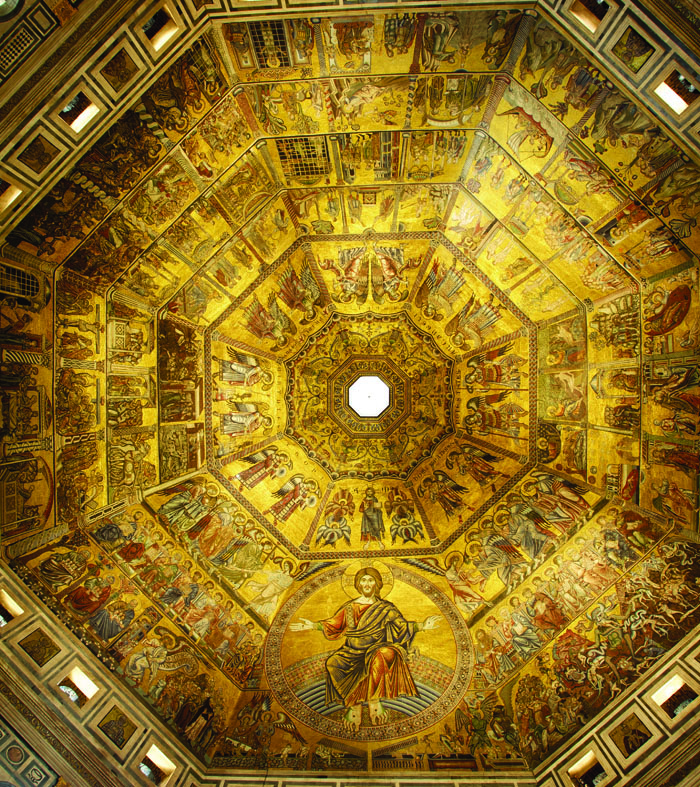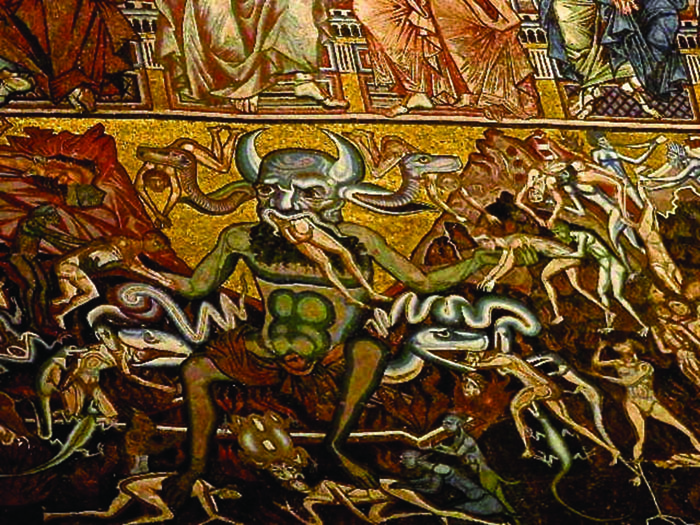The use of gold in mosaic art was introduced in a big way during the early Christian period of the late Roman Empire.

Mosaics dazzle in Christian buildings due to the luxurious splendour created by the gold tiles and the brilliance from the rich colour glass. The individual square shaped tiles are called tessarae (pl.) from the Greek meaning four-sided. The gold tessarae were made by sandwiching 24 carat gold leaf between two slabs of glass which were then melded together in the kiln. Often the mosaics on the walls and ceiling were ungrouted, unlike those on the ground, so as to maximise the penetration and reflection of light generated from the surface. Moreover, the dazzle factor was, and still is today, often compounded by laying the tesserae at slightly different angles to the surface so as to really catch light from all angles.
Christian mosaic decorative cycles were often in highly closed spaces and so the flickering candle light used to light the area would have been an important aid in creating an all encompassing mystical atmosphere. When considered in architectural context, along with the chanting, incense and hypnotic ritual, or Mass, it is no surprise that the interiors of these churches were considered almost midway between Heaven and Earth.
Mosaics were very popular in the Romanesque period (1000-1200s). Vast expanse of wall with small windows are characteristic of this period’s architecture, which lends itself to the mosaic medium. However, it was costly and so reserved typically for the most revered areas of monumental buildings. Gold in decorative art was symbolic of Heaven, the gold mosaic was often in the apse area and areas where the Eucharistic rites were performed. Breathtaking Romanesque religious buildings with jaw dropping mosaic work can be found in Venice (St Mark’s Basilica), Florence (the Baptistery) and Palermo (Monreale Cathedral).

The use of gold in mosaic art was introduced in a big way during the early Christian period of the late Roman Empire, the 4th century AD. Before this, however, mosaic had always been a very common part of the decorative fabric from the Ancient Greek period. The Ancient Greeks, followed by the Romans, used mosaic mostly as floor decoration, using durable materials such as marble, stone, shells. They too decorated some mosaic walls and ceilings and here they did introduce more delicate fragile materials such as glass, for greater effect, but this was not as common.
With the end of Christian persecution in the early 4th century AD and the subsequent elevation of Christianity to one of the official religions of the Empire, the construction era of the great Christian basilicas began, and luxurious gold and brilliant glass colour mosaics were all the rage. St Mary Major, St John in Lateran, St Paul outside the walls and St Peter’s (the four major basilicas in Rome) glowed and shone like Heaven on Earth.
Ravenna was the capital of the Western Roman Empire in the 5th century AD and after its fall it was the capital of the Byzantine possessions in Italy. Without a doubt the mosaic decorations in the religious structures here are some of the most beautiful monuments in the country.
In 1506 Pope Julius II ordered the complete destruction of St Peter’s and the construction for the new and improved basilica began, finished more than one and a half centuries later. It was to be the symbol of the new Rome, after centuries of unrest. Mosaics were to be an important feature in the new decoration. The costly medium reminded all of the great early Christian basilicas and the strength of Christianity. There is only one painting inside St Peter’s basilica, everything else is a mosaic. An official Vatican mosaic workshop was created in the late 16th century and still exists within Vatican city today.
Written by Freya Middleton.
